Recently added
No products
Product successfully added to your shopping cart
There are 0 items in your cart. There is 1 item in your cart.
WRAPPING
How do you get the best out of Pallet Wrapping?
What it can and cannot do.
Typical Equipment for Pallet Wrapping:
 |
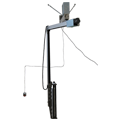 |
 |
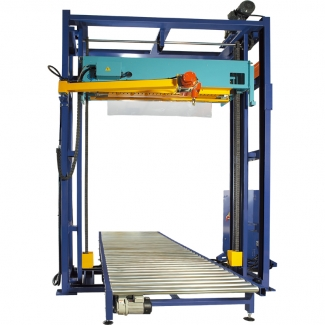 |
| Manual Hand film Dispenser |
Semi-automatic E3 Wrap 2100 |
Automatic EXP-501 |
Fully Automatic EXP-702 |
Process: The development provides a film around one or more products with the aim to stabilise protect and secure the cargo from tampering or theft. There are two main methods of the Pallet Wrapping process; the Vertical Development and the Horizontal Development. The highly stretchable film is wrapped around the item while adjusting the tension, the film provides secondary protection. Other products which can’t resist the tension of the film can be, in principle be damaged. It is thus important that the product packaging is stabilized and maintained before and during the wrapping process.
Pre-Treatment of the Film by winding:
- Brake Pre-Stretching directly from the roll, the core is slowed down while the product/pallet pulling the film from the roll.
- Brake Pre-Stretching using the roller system, and then brake rollers while the product/pallet pulls the film through the rollers.
- Mechanically adjustable brake pre-stretch
- Magnetic / Electric adjustable brake pre-stretch
- Motorized Pre-Stretching through the roller system, rollers regulated product is filmed with minimal tension.
- Fixed for pre-stretch degree
- Variable for pre-stretch grad
- The pre-processed sheet which is used in connection with the above-mentioned processes.
- Fort Solid Film
- Perforated Film
Concepts of Pallet Wrapping Vertical Development:
- Pallet Wrapping Basics: The pallet is wrapped to provide protection and stability of the product for day-to-day transportation.
- Normal. Clear film for the general distribution
- Pallet Wrapping and Storage: The pallet is wrapped for stability and protection of the product over time, including:
- Dust proof pallet wrapping, top film used
- Waterproof pallet wrapping, top film used
- UV light protection for the product
- Black film for theft/tamper proofing "expensive" products
- Film with special properties such as anti-rust etc.
- The sealing of the product
- Other variables in the wrapping process:
- Number of top and bottom turns. This is governed either by time or by number. Number is the best solution.
- The Cycle:
- Bottom – top – bottom
- Bottom high speed to the top - bottom
- Top – bottom
- bottom – mid position – top – bottom
- bottom – top – level down under top film- pause – top - bottom
- Single level
- Pallet Wrapping and Storage: The pallet is wrapped for stability and protection of the product over time, including:
- Normal. Clear film for the general distribution
Applicable equipment in relation to different processes:
- Manual:
General: The physical dimension such as height and weight, the handling limitations of manual hand wrapping.- Hand Films dispenser for hand film 450 or 500mm width.
- Hand Films handles for mini rollers 100 to 125mm width.
- Hand preferred films for direct winding without a secondary tool.
- Semi-automatic:
General: The physical dimension such. height, diameter and weight put restrictions on what the machines can perform. Each machine series will typically have a number of options that enable greater dimension, weight and diameter, this applies to all machines semi-automatic, automatic and fully automatic.
Basic Machine Concepts:-
-
- Tower type with the turntable, the pallet is rotating while being wrapped.
- Satellite type of unit where the film is wrapped around the stationary pallet.
- Tower type turntable with horizontal rolls where the product is rolled and rotated.
- Combining turntable, satellite aggregates leads to extreme process speeds.
-
- Semi Automatic Pallet Wrapping EXP-408, where you manually attach the film to the pallet before the process starts and automatically cuts the film when the process is completed. Basic Solution.
- Semi Automatic Pallet Wrapping EXP-108, where you manually attach the film to the pallet before the process started, but the machine itself, cut the film when the process is completed. Advanced Solution.
- Best film with a manual process where the wrapper has a pause function.
-
- Automatic:
- Automatic Pallet Wrapper EXP-501 which can start the process automatically and holds the film after cutting, ready for the next pallet to wrap. The only manual work is loading/unloading of the pallet which in turn is handled manually by truck or pallet truck.
- The Best film with a manual process or automated integrated solution is the STEP HB 800.
- Fully Automatic:
- Fully Automatic Pallet Wrapping EXP-202A is a process where the machines develop and manage the pallet without human intervention. The pallet is transported onto the taxiways, wrapped and carried out subsequently. It is important that the pallet has the necessary stability for the internal transport.
- Top films such as Fully Automatic Integrated Solution.
- Other equipment which may advantageously be integrated around the wrapping process:
- Weighing of the pallet with integrated weight system.
- Data collection around the packed pallet. The data are collected and stored up against the ERP system using the STEP Data Exchange System.
- Scanning the pallet registration number.
- Weighing Function.
- Pallet dimension measurements.
- Image capture of the pallet
- 360-degree video capture of the pallet
- Top film dispenser.
- Top plate for stabilisation of the pallet during wrapping.
- Taxiways on the turntable and / outlets for manual or automatic pallet change.
- Label marking of the pallet.
Typical process rates in the choice of machine type/process, depending on the sum function, pallet dimensions, product, movie selection, etc.
| Manual: | 5-10 pallets day. A person will presumably be able to wrap more pallets per day but it is definitely not recommended as a permanent solution for regular pallet wrapping due to the negative impact working environment-wise. |
| Semi-automatic: | 5- 100 pallets a day |
| Automatic: | 5-30 Pallets per hour |
| Fully Automatic: | 5-45 Pallets per hour |
Fully Automatic Pallet Wrapping, projected full-optimal solutions, up to 70-100 pallets per hour.
Advanced wrapping and packaging lines with the incorporation of many types of processes in the project specified solution concepts and lines. In many cases, several technologies are implemented to ensure optimal use of each element, whereby material and energy consumption is minimised. Data are collected and processed to ensure the right quality and information.
Other types of machines and equipment for Wrapping
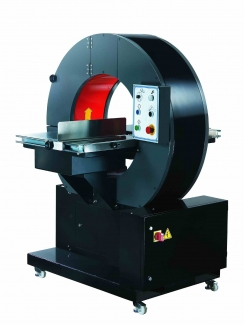 |
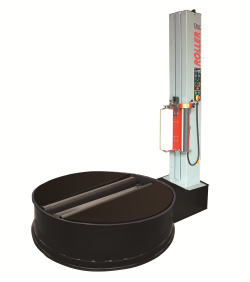 |
 |
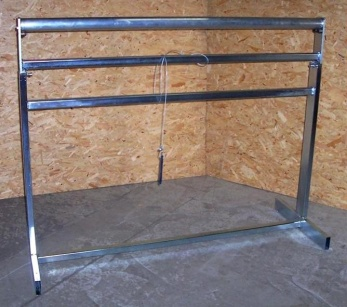 |
| Horizontal Wrapping EXR-401 |
Roll wrapping | Data capture pakke STEP Data Exchange System |
Top films Dispenser STEP TF 1500 |
Film Types:
General consideration and reality:
It is expensive to use an inexpensive film
It is extremely important that the correct film used for the right purpose, so make sure you get a price optimal development of its product. This choice, start by selecting the machine, aggregate type, process point in relation to your production flow, material selection and secondary processes that affect the entire packaging process, mixed stability by moving internally from the process point to the moth.
- Hand Film:
- LDPE cast or blown, clear, white, black, other colors Additional Features: UV, rust protection
- Thickness: 9 to 35my
- Width: 450-500mm for hand film on core ø50 - ø76 and core movable type. Hand Scrolls 75 to 150mm on core ø76.
- Pre-stretch: regular, Pre-stretched.
- Machine Film:
- LDPE cast or blown, clear, white, black, other colors Additional Features: UV resistant, UV, rust protection, perforated holes, added glue, etc.
- Butene / Hektene types of short chains. LDPE Low Density with limited characteristics about the strength and elongation. STEP Basic Stretch
- Oktene types of long and branched chains. Octene LLDPE Linear Low Density with good general properties such as strength and elongation. STEP Advanced Stretch
- Metallocene types with numerous and widely branched Chain Metallocene catalyst is not a monomer such as ethylene, but the film producer of the donor represent. Especially good strength, tear and elongation properties. STEP ultimate stretch.
- Thickness: 9:02 35my
- Width: 500mm ø76mm on the core and the outer diameter up to 250mm, common European hemming. Jumbo rolls of width 750mm with an outer diameter up to ø450mm.
- Pre-stretch degree: 100% to 400%, Pre-stretched. The typical commercial products in Denmark are 150%, 280% and 300% Pre-stretch degree.
- Interior or exterior glue.
- Invoicing of film gross to net DKK / kg or gross to net DKK / roll with a number of meters in thickness given
- Hemming: Machine Film wrap on pallets typically 2 or 3 layers upright. Film Rolls should not lie down for the sake of balance, excitation and crib conditions during storage. Each layer is typically packed with either 15 (within a EURO pallet without an overhang) or 22 in which the film roll is packaged with an overhang on the pallet. Other variants exist.
- LDPE cast or blown, clear, white, black, other colors Additional Features: UV resistant, UV, rust protection, perforated holes, added glue, etc.
Environmental Conditions:
PE material composition is of particular interest as this is often hot welded:
| Polyethylene | ca. 98 % |
| Color pigments are not toxic | ca. 1-2 % |
Toxic and Reaction Properties:
Polyethylene is chemically and biologically inert. Polyethylene can be used directly for food.
Physical Contact:
There is no risk, beyond the mechanical.
Welding, Gluing and Printing of PE Materials:
It is recommended to have the workplace have an outside ventilation to avoid exposure to welding fumes from plastic welding. If welding at a room temperature below 150 degrees, smoke and steam generation is considered to be insignificant. It is recommended that you always provide adequate ventilation for the sake of the general welfare of the workers.
PE can be used in friction welding and ultrasonic welding without the need of suction, as all welding fumes go into cables in the weld zone.
PE has a low surface tension and therefore can only be glued and applied to the text for the treatment of the surface.
Flammability:
When the polyethylene is heated, the material will melt at approx. 109-125 degrees.
Burning:
Controlled burning is recommended. When ignited, the material will continue to burn, even after the ignition source is removed. The decomposition produces H20 and CO2. If burned with a low presence of oxygen, the combustion will also produce a mono oxide, which is toxic.
Recycling:
PE materials are suitable for recycling.
The Author of the Article:
Gunnar Salbæk
CEO/Industrial Design with 30 years of experience in the field.




 E3Hallbrook Ergonomical
Packaging Tables & Solutions
E3Hallbrook Ergonomical
Packaging Tables & Solutions E3Hallbrook Standard Pallet
Wrappers
E3Hallbrook Standard Pallet
Wrappers E3Hallbrook Special Project
Based Pallet Wrappers
E3Hallbrook Special Project
Based Pallet Wrappers
 Manual for PP, PET and WG
strap
Manual for PP, PET and WG
strap Battery tools for PET and
PP
strap
Battery tools for PET and
PP
strap Pneumatic tools for PP and
Steel strap
Pneumatic tools for PP and
Steel strap Strap wagons PP, PET, WG
and
steel strap
Strap wagons PP, PET, WG
and
steel strap Steel Strapping Hand
Tools
Steel Strapping Hand
Tools Pallet strap rods
Pallet strap rods Steep Strap Cutters
Steep Strap Cutters Batteries for Battery
Tools
Batteries for Battery
Tools Semi Automatic strapping
machines
Semi Automatic strapping
machines E3 Hallbrook Ergonomic
strapping solutions
E3 Hallbrook Ergonomic
strapping solutions Pallet strapping
machines
Pallet strapping
machines Side seal strapping
machines
Side seal strapping
machines PP Strap materials
PP Strap materials PET Strap
PET Strap Steep Strap
Steep Strap WG Strap
WG Strap Strapping Machines with
Arch
for 9-12-15,5 mm PP Strap
Strapping Machines with
Arch
for 9-12-15,5 mm PP Strap High Speed 5-6 or 9 mm PP
strap
High Speed 5-6 or 9 mm PP
strap Side seal machines PP
Strap
Side seal machines PP
Strap STEP ZD-08 Table Type Mini
Automatic Strapping Machine
STEP ZD-08 Table Type Mini
Automatic Strapping Machine Full Pallet Bargins for
Strap
Full Pallet Bargins for
Strap High speed transit 5-6 or
9mm PP straping machines
High speed transit 5-6 or
9mm PP straping machines Transit PP strapping
machines 9, 12 or 15,5 mm
Transit PP strapping
machines 9, 12 or 15,5 mm Pallet Strapping
machines
Pallet Strapping
machines Project Strapping
Machines
Project Strapping
Machines Fishing and Food
Industry
Fishing and Food
Industry Corrugated industry,
Strapping Machines for
Corrugated industry,
Strapping Machines for Printing Industry
Printing Industry
 E3 Wrap 2100 Semi Automatic
Pallet Wrapper
E3 Wrap 2100 Semi Automatic
Pallet Wrapper E3 Wrap 2100 Series Special
Applications and Options
E3 Wrap 2100 Series Special
Applications and Options Hand Film Dispenser For
Hand
Film
Hand Film Dispenser For
Hand
Film Top Film Dispensers
Top Film Dispensers STEP Semi-Automatic
Turntable Pallet Wrapper
STEP Semi-Automatic
Turntable Pallet Wrapper STEP Robot Pallet
Wrappers
STEP Robot Pallet
Wrappers STEP Automatic Pallet
Wrappers with Remote Start
STEP Automatic Pallet
Wrappers with Remote Start Fully Automatic Pallet
Wrapping Lines
Fully Automatic Pallet
Wrapping Lines Stretch Hood Pallet
Wrapping
Stretch Hood Pallet
Wrapping Horizontal Wrappers
Horizontal Wrappers
 Banding Materials
Banding Materials Banding Machines Table
Top
Banding Machines Table
Top STEP M-Series Banders Tape, Label, Stretch, and Automated Stacker Machines
STEP M-Series Banders Tape, Label, Stretch, and Automated Stacker Machines STEP String Tiers
STEP String Tiers String for Tying
String for Tying
 Portable Sealers
Portable Sealers Hand Impulse Sealers
Hand Impulse Sealers Foot Stand Sealer
Foot Stand Sealer I-Bar Impulse Sealers
I-Bar Impulse Sealers Automatic Impulse
Sealers
Automatic Impulse
Sealers Band Sealers
Band Sealers Pharmaceutical Sealers
Pharmaceutical Sealers Tube Film on rolls
Tube Film on rolls Packaging of Food
Packaging of Food Sack Tiers, Drill Tool
Sack Tiers, Drill Tool Bag and Sack closers with
tape
Bag and Sack closers with
tape Bag Closing Machines with
Sewing
Bag Closing Machines with
Sewing Thread for Sewing
Machines
Thread for Sewing
Machines Sack & Bag closing
lines
with sewing machines
Sack & Bag closing
lines
with sewing machines PE Bags for Sealers
PE Bags for Sealers Aluminum Vacuum Bags
Aluminum Vacuum Bags
 Polyolefin Shrink Film
Polyolefin Shrink Film PE Shrink Film
PE Shrink Film Heat Shrink Guns
Heat Shrink Guns Skin Packaging
Skin Packaging Shrink Packaging Machines
& Systems
Shrink Packaging Machines
& Systems
 STEP AGV Solutions
STEP AGV Solutions STEP Robotics, Robots &
Grippers
STEP Robotics, Robots &
Grippers Belt Conveyors
Belt Conveyors Vibrators, Product feed
& sorting
Vibrators, Product feed
& sorting Vacuum Lifting &
Handling Systems
Vacuum Lifting &
Handling Systems Telescopic Unloading
Conveyors & Systems
Telescopic Unloading
Conveyors & Systems Weighing Scale - Pallet
& Platform Scales
Weighing Scale - Pallet
& Platform Scales
 Multihead Weighers
Multihead Weighers Mini Table Top Weighers
Mini Table Top Weighers VFFS Packaging Machines
VFFS Packaging Machines Doybag Packaging
Machines
Doybag Packaging
Machines Flow Pack Machines
Flow Pack Machines Rotary Fillers
Rotary Fillers Vacuum/Gas Horizontal Flow
Packaging
Vacuum/Gas Horizontal Flow
Packaging VFFS Packaging Lines
VFFS Packaging Lines Conveyors for Multihead
& VFFS packaging lines
Conveyors for Multihead
& VFFS packaging lines
 Carton Closing
Carton Closing Tape Dispensers
Tape Dispensers Tapemeter
Tapemeter Tapes and Adhesive
Rolls
Tapes and Adhesive
Rolls Protection in Rolls
Cardboard-Bubble-Foam
Protection in Rolls
Cardboard-Bubble-Foam Manual and Pneumatic
Staplers
Manual and Pneumatic
Staplers Carton Erectors
Carton Erectors
 Document Pouches
Document Pouches Protection in Rolls, foam,
card board
Protection in Rolls, foam,
card board PP, PET, Steel strap, WG
strap
PP, PET, Steel strap, WG
strap Cardboard Boxes
Cardboard Boxes Stretch film & Hand
wrap
film
Stretch film & Hand
wrap
film Shrink film
Shrink film Topfilm for paller
Topfilm for paller Strings for Packaging
Strings for Packaging Bags for Packaging
Bags for Packaging Seals, metal buckels and
plastic buckles
Seals, metal buckels and
plastic buckles Banding tape
Banding tape Kraft Paper, Fidele,
Packaging Paper
Kraft Paper, Fidele,
Packaging Paper Film knives and Clips
removers
Film knives and Clips
removers Corner and Edge
Protection
Corner and Edge
Protection Manila labels, Manila clips
& Rubber bands
Manila labels, Manila clips
& Rubber bands Labels for Packaging
Labels for Packaging Packaging Tapes
Packaging Tapes
 Production Machines for
Sample Making
Production Machines for
Sample Making
 Battery for Battery
tensioners and sealers
Battery for Battery
tensioners and sealers Used Packaging Machines
Used Packaging Machines